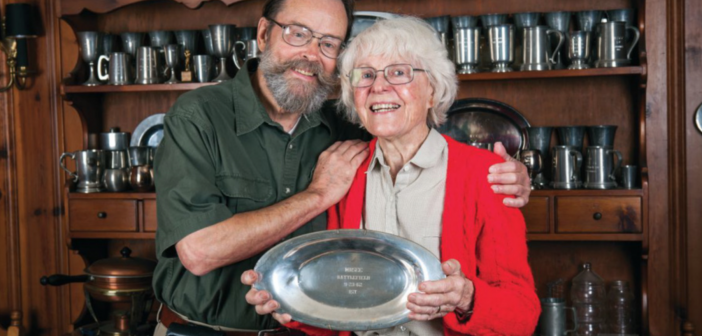Regie Johnson’s days competing in autocross
By James Rada, Jr. | Photography by Casey Martin
Five years ago, Gettysburg resident Regie Johnson and her husband, Keith, were window shopping at a Jaguar dealership in West Virginia. Regie, who describes herself as “old enough to be on Medicare,” has an eye for fine automobiles. Although the Johnsons weren’t in the market to buy, they showed enough interest in the cars that they were invited to a special luncheon hosted by the dealership.
The luncheon was catered at a racetrack so guests could test drive one of three Jaguar models. Regie got behind the wheel and drove around the crowded track. She told the salesperson, who was in the car with her, that she’d like to see how it would really perform.
He was skeptical, but he set up a pylon course and cleared the track of other drivers. “Regie went around the course and those pylons like a pro,” Keith says.
“I was impressed. She has a great, natural talent for driving sports cars.”
Keith shouldn’t have been too surprised. Regie competed in autocross competitions from 1963 to 1975, piling up dozens of trophies along the way. They crowd shelves and counters in a second home that she and Keith have in Thurmont, Md.
Autocrossing is an intense battle against time, accelerating into the straights, steering, double-clutching, and braking into corners and racing around a complicated course that drivers memorize in practice sessions. Brake and clutch pedals, gear shift lever, and steering wheel are worked in precise, lightning-fast coordination to complete the course a thousandth of a second faster than the competition.
Most competitors drive production cars, while some are modified. They run in different classes for the fastest time. The events are generally held on a large parking lot or racetracks. Occasionally, Regie would compete on a drag strip, but she didn’t like those events because she says they were “go straight then stop.”
Because the autocross field is smaller than a racetrack, the competitors can’t build up the speed that drivers do on a racetrack. “You get the most out of first and second gear, though,” Regie says.
Regie became interested in autocross after watching a similar type of competition called gymkhana in Frederick, Md. “I thought it would be a good way to have fun and learn how to better handle cars,” Regie says.
Among the things she learned from autocrossing on oval tracks was to “keep her foot in it” when going into the oval. She also learned how to drift around turns. This is when the driver oversteers in a turn, causing the loss of traction in the rear wheels while maintaining control of the front wheels through the turn.
She and her first husband got involved in competition so much that they helped found the Mason-Dixon Sports Car Club. The club began sponsoring its own autocross competitions in Gettysburg, Hagerstown, Frederick, and Chambersburg. The club also sponsored speakers, such as Roger Penske, and rallies.
When Regie first started driving, she ran in the Women’s Class in the local competitions. She dominated the competitions and the other women who drove gradually stopped. Since she couldn’t drive in a class by herself, Regie started driving with the men and often found herself beating their times.
“The men did not want me in the same class with them,” Regie says. However, they did tend to measure themselves against her. “Guys would often ask me, ‘What was your time?’ because they wanted to know what they would have to do timewise in their class,” Regie says.
After a season of Regie driving in the Men’s Class locally, they decided they wanted to keep the Men’s Class male only. So, Regie started driving in autocrosses in Washington, D.C., which had larger competitions and an active Women’s Class.
Autocross then started indexing the drivers. This formula adjusted for a variety of factors to make the men’s and women’s times comparable as well as the times between different size vehicles. When that was done, Regie typically placed among the best men’s times. Even without the index, she sometimes won the fastest time of the day, beating out all men and women. She typically drove a Porsche 356, a Porsche 911, or a Ferrari 250.
Regie also competed in wintercross competitions. These events often involved driving on snow and ice in a large parking lot. “They certainly taught you something about driving,” Regie says.
Regie unknowingly met her second husband at an autocross competition in Gettysburg called “The Dust Bowl” because it was held in a grassy field. Keith had an Austin-Healy and wanted to see how well he could do in an autocross. Since Regie was registering the entrants, they realized years later that she must have registered Keith, although neither recalls the other one at the event.
They wouldn’t meet “officially” until years later in 1993. Keith, who had been a life-long bachelor, says, “Somehow, I knew there couldn’t be another woman for me to marry. I saw so sure of it.”
Regie’s most-memorable event was a competition at the Marlboro Racetrack in Maryland. Twenty-two Corvettes competed and the times at the end of the day were indexed. “My time by index would have placed me at No. 2 in the men’s class,” she says.
Regie has earned championship autocrossing status throughout the entire mid-Atlantic region, the District of Columbia, and Gettysburg. Now, long retired from the competition circuit, she still enjoys driving, and when the opportunity arises, such as when she was testing the Jaguar, she will open up and show that she still has the right stuff for competing.



